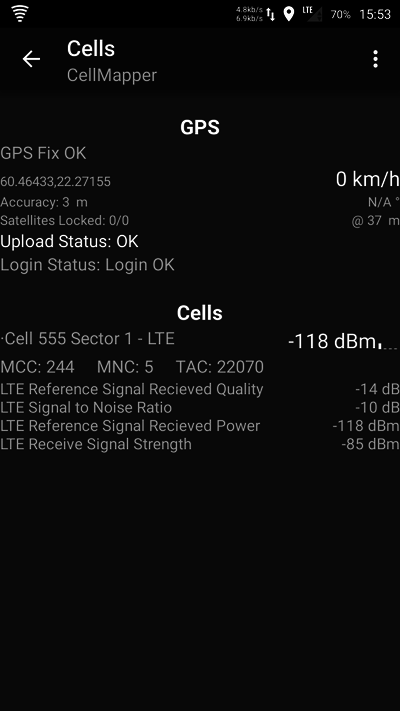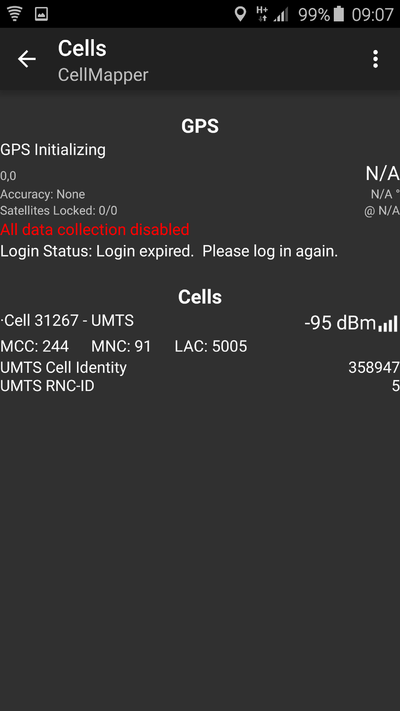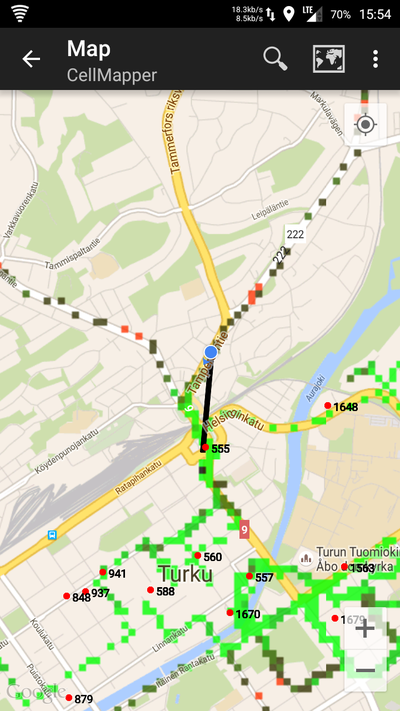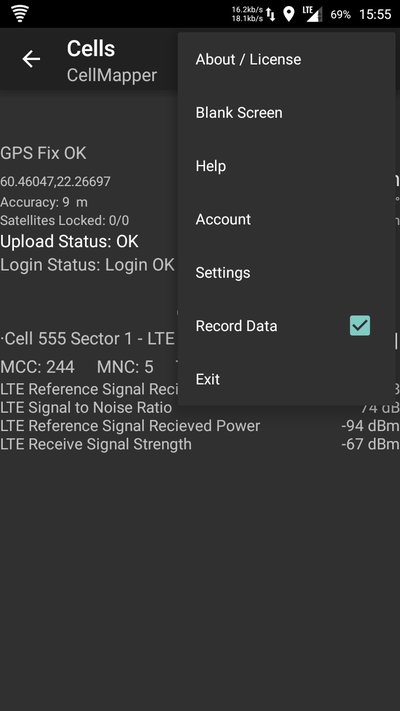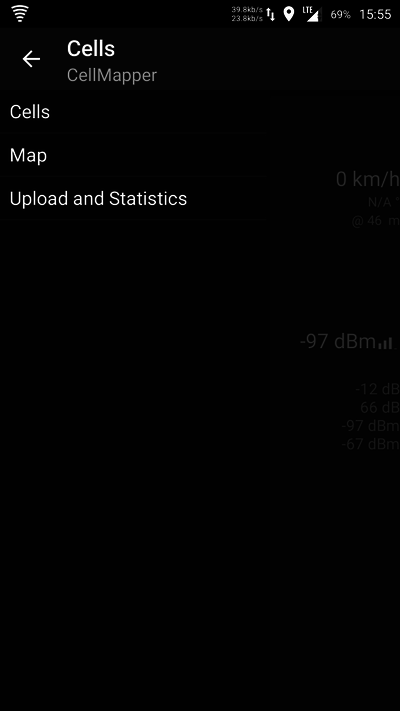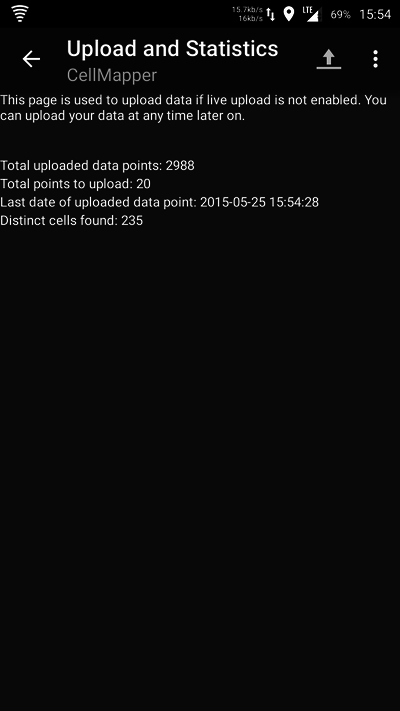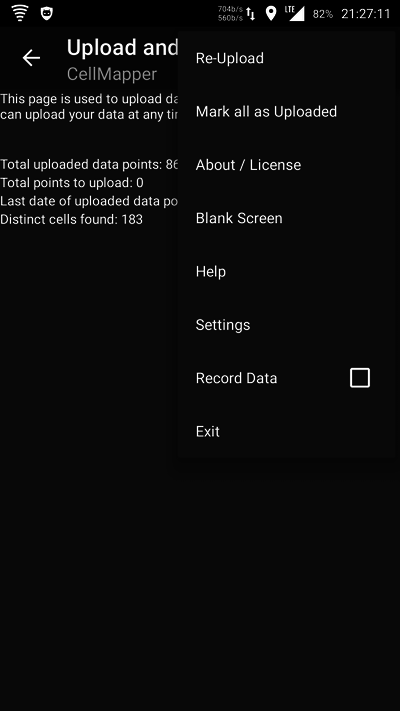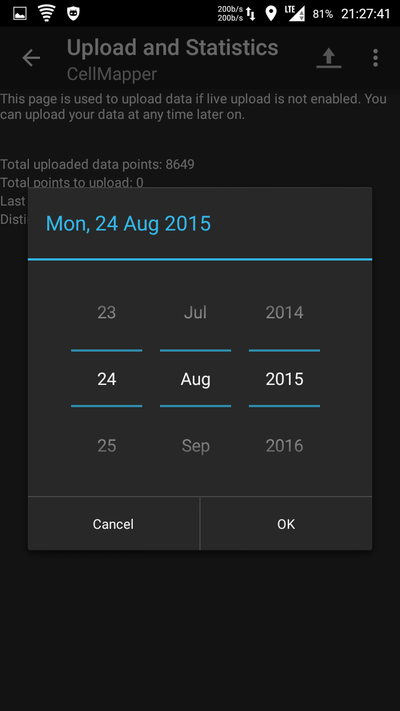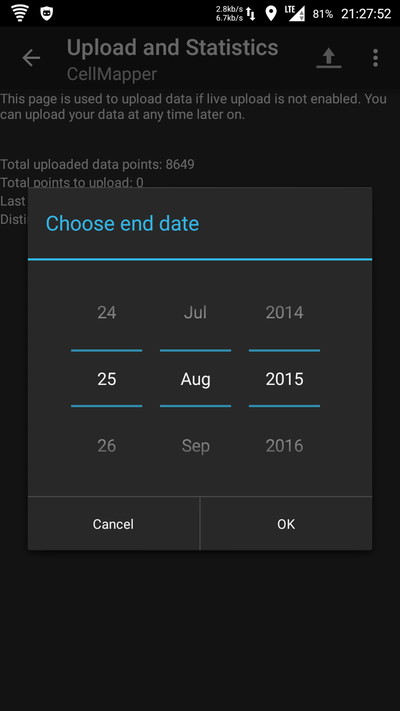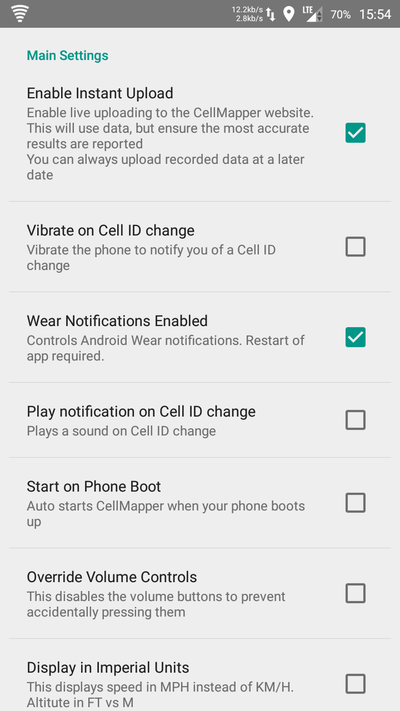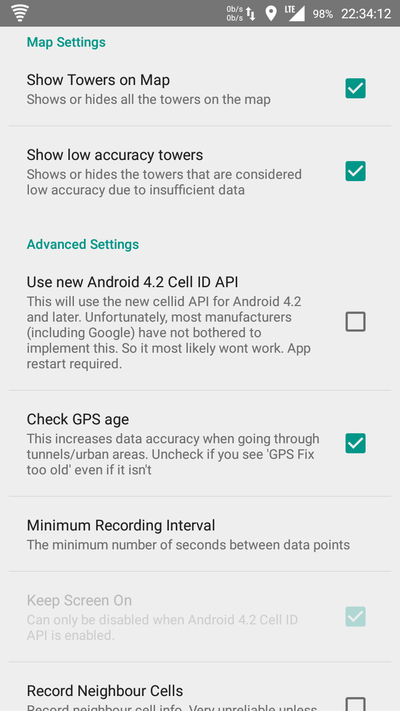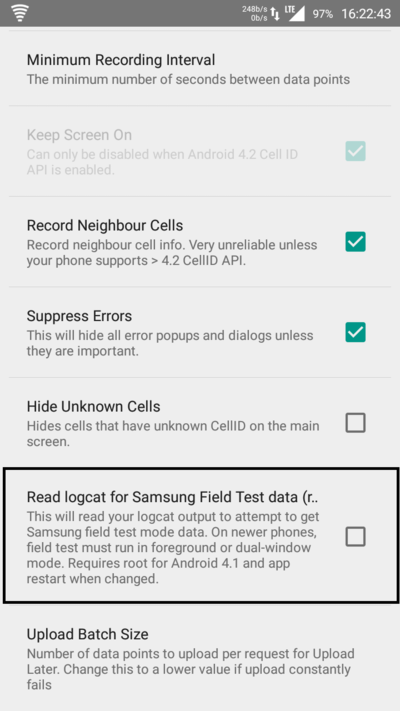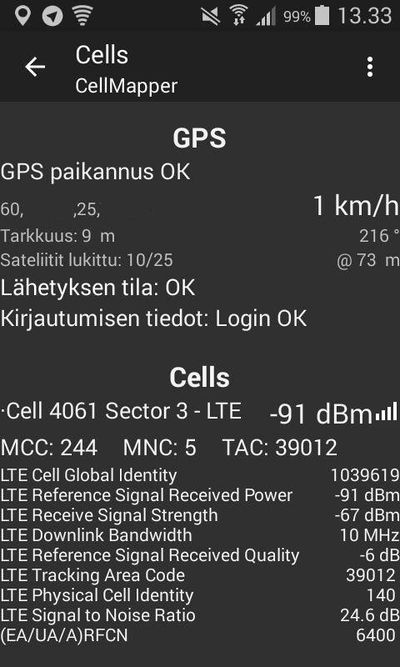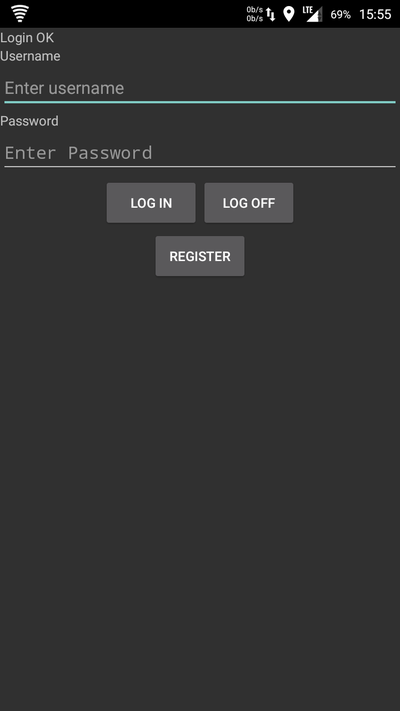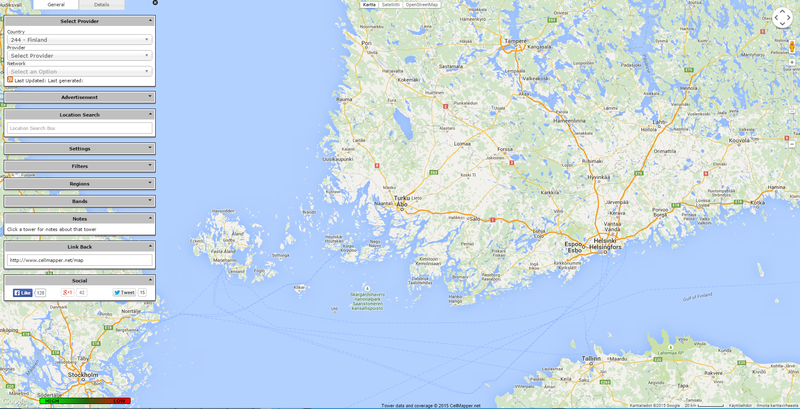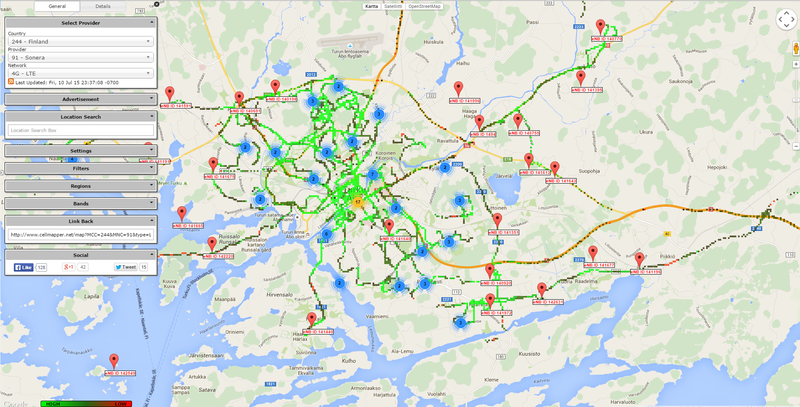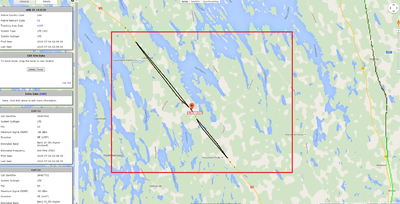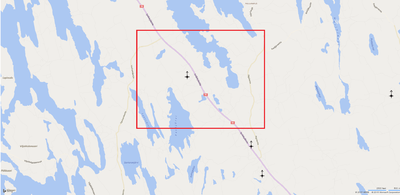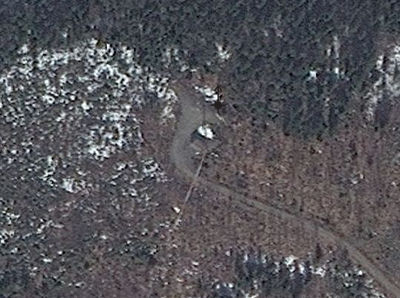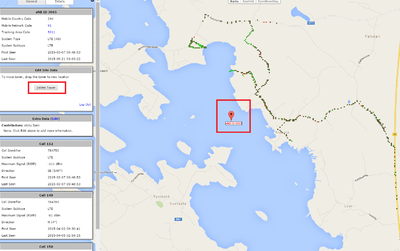Ero sivun ”Cellmapper/en” versioiden välillä
(Ak: Uusi sivu: {| class="wikitable" |- ! Abbreviation !! Explanation !! Example |- | LTE Phycical Cell Identify (PCI) || Only shown in an LTE network || |- | UMTS Primacy Scrambling Code (PSC) |...) |
(Ak: Uusi sivu: For more information on signal values: Mobiiliverkkotekniikka#Tietoa_signaaliarvoista) |
||
| Rivi 106: | Rivi 106: | ||
|} | |} | ||
| − | + | For more information on signal values: [[Mobiiliverkkotekniikka#Tietoa_signaaliarvoista]] | |
=== Map Guide === | === Map Guide === | ||
Versio 5. lokakuuta 2015 kello 09.36
Cellmapper is a useful application for locating 2G/3G/4G base stations. Cellmapper's maps are automatically updated by users who broaden the database by using the application.
Cellmapper's servers calculate the data the users have sent and creates a graphical representation of it in the map delivered by Google Maps, which can be browsed directly from the application or Cellmapper's webpage. The model can not account for certain variables though, so in order to get reliable data one should keep the measuring phone in as clear and unobstructed area as possible. An ideal measuring setting is as unobstructed as possible, such as large fields of prairie, but for instance in cities obstacles are unavoidable. When measuring one should move in 1/2-3/4 circles at different distances around the presumed base station in order to get the most accurate results.
The application supports real time transfer, so the data collected is sent to Cellmapper's servers as you measure. You can also manually send the data after measuring or resend already collected data. After the files have been sent to the server, they are processed within minutes if there is not much load on the servers at the moment. If the servers are under heavy load then processing data can take up to hours or even a full day. The decay of processing speed is a known issue, and will be addressed in the future.
Cellmapper does not work on Windows Phone or iOS devices since the software they use prevents using the network API. Part of Cellmappers features require rooting your android device, but it works fine without that as well.
While using cellmapper, pay attention to:
- Battery consumption rise (looks for GPS signals and checks network quality)
- Screen won't turn off while application is running (More battery consumption!). If you have a phone with an Amoled -screen you can turn it off for the duration of the measuring from the applications settings.
- Base station location in urban areas is best determined by doing round trips of city blocks. At more rural locations you should do larger sweeps to save time. You will get the best result on flat ground.
- Ensure that you have a sufficiently good connection to the base station as well as a GPS connection.
- Using the application requires that you have a subscription with the operator whose 2G/3G/4G network you are trying to measure. You can only measure stations in the network you are actively connected to, so for instance you can't locate a 4G base station if you are in a 3G network. Usually 2G/3G/4G cells can all be in the same base station, and even be sent from the same panel antenna.
- The application can show that a base station can cover areas up to a hundred kilometers. These errors can be created if the network data collected by the application has great resemblance with some other base station or if the phone has calculated incorrect GPS-data. At this moment these "orphan cells" can't be removed by the user and they are left on the map.
Cellmapper is constantly being developed and the changelogs and devlogs can be found on their webpages: https://www.cellmapper.net/mw/index.php/Feature_Requests
Here is a direct link to their FAQ and answers: https://www.cellmapper.net/mw/index.php/FAQ
If you have something to ask about cellmapper, you should contact the developer directly https://plus.google.com/communities/101488064885764774600
You can donate money to the Cellmapper project. Using donations they aim to keep the servers running and modern enough to accommodate the growing userbase. Each of their servers costs about 73$CAD (Canadian dollars) upkeep every month.
Sisällysluettelo
Usage
1. Download for Android Cellmapper application.
2. Enable GPS (not Google's location service)
Location services can be enabled in Samsung devices in : Settings -> Location services -> Use GPS satellites
3. Start the application. Ensure that you are connected to the 2G/3G/4G base station that you wish to measure. You need to have a data plan / contract with the operator, whose connection you wish to measure.
In the Cell List tab you can see if GPS has been connected properly (GPS OK) as well as your base stations information.
In the picture we have connected to "Cell 555" base station in Elisa's LTE network. GPS has determined location by 3 meters accuracy and 0 out of 0 satellites have been connected to (they were connected to, but some bug made it appear they had not been connected to). Login OK means that I have also logged myself in to the Cellmapper application. By logging in to the application your username will be shown in the Cellmapper map (internet browser map).
| Abbreviation | Explanation | Example |
|---|---|---|
| Cell | Cell ID, this is used to differentiate cells from each other | Cell 141047 |
| Sector | The sector number of a cell | Sector 21 |
| MCC (Mobile Country Code) | The mobile network country-specific code | 244 (Finland) |
| MNC (Mobile Network Code) | Operator-specific mobile network code | 5 (Elisa), 12 (DNA), 91 (Sonera) |
| LTE Cell Global Identify (CGI ) | Base station ID, used to differentiate base stations from each other | 36108053 |
| LTE Reference Signal Received Quality (RSRQ ) | Quality of received signal | -6dB |
| LTE Signal to Noise Ratio (SINR - Signal-to-interference-plus-noise ratio) | The scale of the SINR measurements are between -20 and +30dB, the bigger the better. Signal strength is though of as "OK" when it is 15dB or over that, the maximum speed is then 50Mbps. You will need roughly 25dB if you wish to reach speeds around 100Mbps. All speed estimations are made using the 20Mhz bandwidth. | 28dB |
| LTE Reference Signal Recieved Power (RSRP ) | Interprets the quality of the incoming reference signal. -50dBm is the best, -90dBm is good and -110dBm is weak. When the signal is better than -90dBm we can follow the SINR value alone. | -65dBm |
| LTE Received Signal Strength Indicator (RSSI) | Interprets the strength of the incoming radio signal. | -51dBm |
| UMTS RNC-ID | 5 | |
| TAC (Tracking Area Code) | Tells the area code consisting of multiple base stations. | 4050 |
| LAC (Local Area Code) | Tells the area code consisting of multiple base stations. | 5005 |
The way information is shown here will depend on different phone models. This screenshot has been taken using a Samsung S3 4G I9305.
Here is some additional information if you are using a newer model phone or API 4.2. You can ask for more information from our taistowiki community or in our murobbs thread, murobbs is in Finnish only.
| Abbreviation | Explanation | Example |
|---|---|---|
| LTE Phycical Cell Identify (PCI) | Only shown in an LTE network | |
| UMTS Primacy Scrambling Code (PSC) | Only shown in a 3G network | |
| Channel Quality Indicator | ||
| Cell Identify | Same as Cell Physical Identify | |
| Data Source Delay | 00.006 | |
| Data Source | oem_ril |
For more information on signal values: Mobiiliverkkotekniikka#Tietoa_signaaliarvoista
Map Guide
The map opens from the left side menu.
Maps välilehdessä näet jo skannattujen tukiasemien arvioitu sijainti. Sovellus automaattisesti näyttää juuri nyt käytettävän verkon tukiasemat (kuvassa Elisan LTE). Tukiasemien sijanteja voi katsoa myös Cellmapperin kartasta .
The base station is marked on the map as a red dot in mobile and a red arrow in a browser. A blue dot refers to your own location and the black line tells you which station you are connected to. By clicking on the base station you can see it's range as a black zone. Light green indicates best signal quality, dark green good quality, black average quality and red the weakest signal quality.
Select Provider (haku ikoni) voit vaihtaa operaattoria ja verkkoa, jos haluat katsoa muiden verkkojen tukiasemia.
Put a tick into Record Data so that you measurements will be collected for uploading.
Send data to server
5. Upload your recorded data to the Cellmapper server by opening the Cell List tab and Upload and Statistics tab. You should always upload your newly measured base station so that somebody else won't have to go and redo it, and they can instead view it from the map. The cellmapper map is updated nearly instantaneously .
6. Press on the Upload icon after this and the data will be sent to the server. We recommend that you also turn on the Enable instant upload feature from the settings, so you don't have to press the button every time.
7. Close cellmapper after use so it won't drain your whole battery.
Resend data to server
Load the data to Cellmapper servers by selecting Upload and Statistics from the menu.
Open the menu and select Re-Upload.
Select the starting date and time of which the data will be reuploaded.
Select the end date and time of which the data will be reuploaded. Now when you press OK the phone will start to send data collected from between the starting and end date to the server, if an internet connection is available. Depending on the amount of data you have to send the process could take anything from a few seconds to a few minutes.
Settings
Automatic data upload
This enables the cellmapper application to automatically transmit data to the cellmapper servers that you have collected of a base station.
Open the application settings and put a tick in Enable Instant Upload.
Show base stations on the map
This function shows base stations on the map. By default this feature is enabled.
Show inaccurate base stations
This feature shows inaccurately measured base stations on the map. Inaccurate base stations are stations which only have one cell or stations that have not been measured properly due to low signal values. You can improve the accuracy by measuring the station in closer proximity to it. Other overlapping base stations can also be inaccurately measured automatically as you are trying to measure some other station. You can also make a station accurate by manually locating it correctly on the map. This feature is disabled by default.
Android Cell ID API 4.2
This feature only works in Android 4.2 and Cell ID API 4.2 supported devices. Most manufacturers (such as Google) do no support this feature, so it is unlikely that your device will. Although, many new Samsung, LG and Sony devices support this feature. OnePlusOne gives incorrect information when measuring 3G, but the 2G and LTE network measuring works fine.
Kun käytät API 4.2 puhelimessasi, niin odota hetki ennen mittauksien aloittamista. Puhelin ei näytä heti sovelluksen käynnistyessä oikeaa dataa... Pitäisi näkyä parin sekunnin kuluttua...
Check if your device supports this feature: https://www.cellmapper.net/mw/index.php/Android_4.2_CellID_Support
You can test the feature to see if it works correctly on your device. This requires restarting the application.
API 4.2 advantages:
- Enables turning off your screen during measuring
- Enables measuring and logging several cells at the same time from the same operator's network. This method can have some hiccups and bugs, so most stations measured this way will be shown as inaccurate base stations.
Check GPS age
This feature checks that your GPS information is fresh. We recommend enabling this.
Frequencies
Cellmapper voi mitata mobiiliverkon taajuuksia Samsungin / Sonyn field test modella (tämä vaatii root oikeudet). Sinun siis tulee rootata puhelimesi (menetät takuun tässä jos tämän teet). Sen jälkeen otat käyttöön Cellmapperin asetuksista Read logcat for Samsung/Sony Field Test data. Soneran ja DNA LTE taajuudet tulevat automaattisesti selaimen kartalle joten tätä ei tarvita näissä verkoissa. Elisan LTE:tä ei ole mahdollista saada erotettua 800/1800 LTE verkkoja valmiiksi, ainut tapa mittailla rootatuilla Samsung / Sony laitteilla. Tukea kehitetään muillekkin laitteille. Tämä siis ei toimi custom romeissa. Testaa soittaa *#0011# (vain Samsung) niin näet sieltä Band numeron. Suomessa on käytössä pääasiassa LTE band 20 (800Mhz) ja 3 (1800Mhz) sekä kaupunkialueella 7 (2600Mhz).
.
Alla näkymä Cellmapperin pääsivulta, kun ohjelma lukee Samsung ServiceModen tietoja.
Operator's LTE sectors and corresponding frequencies.
| Operator | Sector | Frequency | Other |
|---|---|---|---|
| DNA | 1, 2, 3 | 1800Mhz | |
| DNA | 10, 20, 30, 40 | 800Mhz | |
| Elisa | 1, 2, 3 | 800Mhz / 1800Mhz | |
| Elisa | 4, 5, 6 | 2600Mhz | |
| Sonera | 11, 21, 31 | 1800Mhz | |
| Sonera | 12, 22, 32 | 800Mhz | |
| Sonera | 10, 20, 30 | 2600Mhz | |
| Sonera and DNA | 13 | 800Mhz | Shared network |
| Sonera and DNA | 23, 33 | 1800Mhz | Shared network |
Users
Cellmapper collects information about your client device, for instance location, make and model, operator and other network information. You can view the precise list on cellmapper's website.
You can register an account for the cellmapper application and log in to it easily. Registering an account doesn't take much, just a username, e-mail and password. You can see your login state from Cells: Login OK .
Web browser map
You can easily access the cellmapper web map using your browser at https://www.cellmapper.net/map
From the left you can select Country, Provider/Operator and Network.
After filling those in the map will load already mapped stations found by your criteria. We selected Finland, Sonera and LTE and took a glance at the Turku map.
From the menu on the left you can select which frequencies are shown by clicking bands. This feature works only if the providers network allows measuring them, such as Sonera LTE and DNA LTE. You can also select Show low Accuracy Towers to see more base stations. These stations are either inaccurate and can only have one or two cells. Also weakly measured stations won't be shown without this filter, until they have been measured more accurately.
By the colours you can see the signal strength. Light green means good connection and dark green OK connection. Red means really shitty connection. If there's black it means there is no connection at all.
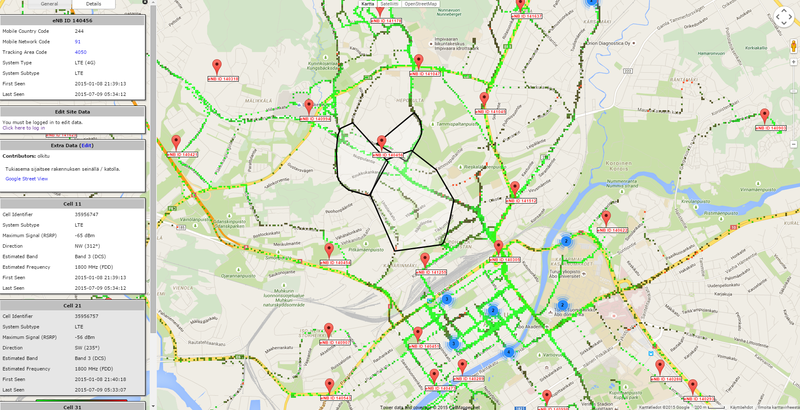
Click on a base station to get more information about it. On the left for instance you can see when it was first and last measured, the best signal established to a cell (RSPR) and the frequency, if available. Most commonly base stations have three cells which point off to different directions. If a base station is marked in the wrong place on the map and you know the correct and precise location, you can move the base station by logging in under Edit Site Data and pressing Click here to log in. Username and password are the same as in the cellmapper application, so this requires registration.
In Extra Data you can write more information about the base station in question or other things. You can also attach a picture of the station if you so desire. Credentials to do this should be sought out from the cellmapper community.
Kartassa tukiaseman siirtäminen ja poisto
Vain kokeenneille käyttäjille jotka ymmärtävät miten tämä toimii. Laittakaa mielummin suoraan vaikka Taiston ylläpitoon viestiä niin teemme puoleastasi. Turhien tukiasemien poisto / siirto aiheuttavat vain enemmän ongelmia.
Kirjaudu Cellmapperiin kartta tunnuksilla (ei Cellmapper wiki tai foorumi tunnuksilla) tästä, jos sinulla ei ole tunnuksia, voit rekisteröityä tästä. Jos olet unohtanut salasanasi, voit resetoida täältä.
Kun olet kirjautunut onnistuneesti, sivu ilmoittaa Login successful (kirjautuminen onnistui). Tämän jälkeen palaa karttaan tästä.
Tukiasemien siirtoon ei ole mitään järkevää ohjetta mutta muista se maalaisjärki ja nämä vinkit:
- Sateliittikuvista yritä erottaa tukiasemat lähialueelta.
- Katso mastokarttaa. http://testi.jles.me/mastot/
Tämän jälkeen katso miten tukiaseman solut kantavat. 800Mhz kantaa tietenkin pidemmälle kuin 1800Mhz mutta ei tietenkään yli 20km päähän ainakaan kanna, voi olla virheellistä dataa.
- Klikkaa tukiasemaa ja katso minne kantaa.
- Katso RSRP arvot, mitkä ovat maksimit. Pienin on useinkin silloin luotettavin ja lisäksi solun ilman suunta.
Esimerkki: Mikkelistä etelään on paikka Harjunmaa tukiasema eNB ID 142530. Cellmapperillä on joku mitannut keskellä valtatietä 13 mutta haluamme siirtää se tarkalleen oikealle sijainnille.
Vaihtoehtona on tutkia sateliittikuvaa suoraan mutta totta kai kannattaa säästää vaivaa ja katsoa masto karttaa missä mastoja olisi.
Tämä on helppo koska mastoja on vain yksi lähettyvillä ja voidaan olettaa että ei ole muutakaan mastoa siinä lähettyville. Suosittelen maston siirtoa varten sateliittikartan niin näet millaista maastoa alueella on. Vielä kun lähdettiin tarkentamaan mastot kartassa ja samalla Cellmapperin kartasta samaankohtaan niin nähdään mastokin sielä tarkasti. Vedetään hiirellä sitten Cellmapperin kartasta tien varresta tähän sijaintiin.
Sivusto kysyy Are you sure you would like to movie site 142530 to 61.866220238889255,26.98739254474674? Vahvista OK jos on oikealla sijainnilla. Odota hetki kunnes ilmestyy Update Succesfull. Jos tuli virhe, kirjaudu ulos ja kokeile uudelleen. Jos ei auta niin tyhjennä evästeet ja välimuisti ja kokeile vielä uudelleen, muuten ota yhteyttä ylläpitoon.
Nyt tukiasema on siirretty ja Cellmapper generoi uudelleen tukiaseman kantoaluetta. Tässä menee jonkin aikaa riippuen miten tukiasema on ruuhkainen.
Linkki tälle alueelle: http://www.cellmapper.net/map?MCC=244&MNC=91&type=LTE&latitude=61.86903288943261&longitude=26.993256093446345&zoom=15
Tukiasemien poisto ilmoitukset kannattaa laittaa suoraan Murobbs ketjuun. Jos tukiasema kohdistuu juuri kotiisi, voit poistaa sen Delete tower painikkeella. Tukiasema piilotetaan kartalta ja palautuu kartalle jos se myöhemmin uudelleen mittaillaan.
Esimerkki väärästä datasta, suositellaan että vain Cellmapperin käyttäjät jotka tietävät miten virheellinen data tulee poistaa tukiasemat.
